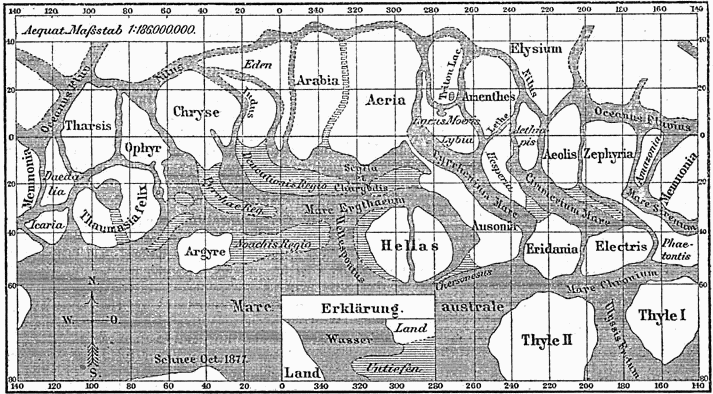by neufer » Sun Nov 29, 2009 11:21 am
http://en.wikipedia.org/wiki/Giovanni_Schiaparelli
<<Giovanni Virginio Schiaparelli (March 14, 1835 – July 4, 1910) was an Italian astronomer and science historian. He worked for over forty years at
Brera Observatory. Schiaparelli demonstrated that the Perseids and Leonids meteor showers were associated with comets.
In Schiaparelli's initial Mars observations, he named the "seas" and "continents" of Mars.


During Mars's "Great Opposition" of 1877, Schiaparelli observed a dense network of linear structures on the surface of Mars which he called "canali" in Italian, meaning "channels" but mistranslated as "canals". While the latter term indicates an artificial construction, the former indicates the connotation that it can also be a natural configuration of the land. From this incorrect translation, various assumptions about life on Mars derived, as the "canals" of Mars soon became famous, giving rise to waves of hypotheses, speculation, and folklore about the possibility of intelligent life on Mars, the Martians.
In his book Life on Mars, Schiaparelli wrote: "Rather than true channels in a form familiar to us, we must imagine depressions in the soil that are not very deep, extended in a straight direction for thousands of miles, over a width of 100, 200 kilometers and maybe more. I have already pointed out that, in the absence of rain on Mars, these channels are probably the main mechanism by which the water (and with it organic life) can spread on the dry surface of the planet.">>
http://apod.nasa.gov/apod/ap091129.html
Layers in a crater in the
Schiaparelli basin as seen by MGS.


Layers in Monument Valley. These are accepted as being formed, at least in part, by water deposition.
Since Mars contains similar layers, water remains as a major cause of layering on Mars.
[quote]http://en.wikipedia.org/wiki/Giovanni_Schiaparelli
<<Giovanni Virginio Schiaparelli (March 14, 1835 – July 4, 1910) was an Italian astronomer and science historian. He worked for over forty years at [url=http://upload.wikimedia.org/wikipedia/commons/2/28/Brera_Astronomical_Observatory.jpg][b]Brera Observatory[/b][/url]. Schiaparelli demonstrated that the Perseids and Leonids meteor showers were associated with comets.
[b]In Schiaparelli's initial Mars observations, he named the "[color=#0000FF]seas[/color]" and "[color=#FF8000]continents[/color]" of Mars.[/b]
[img]http://upload.wikimedia.org/wikipedia/commons/d/dd/Karte_Mars_Schiaparelli_MKL1888.png[/img]
[img]http://upload.wikimedia.org/wikipedia/commons/thumb/b/b7/Mars_G%C3%A9olocalisation.jpg/720px-Mars_G%C3%A9olocalisation.jpg[/img]
During Mars's "Great Opposition" of 1877, Schiaparelli observed a dense network of linear structures on the surface of Mars which he called "canali" in Italian, meaning "channels" but mistranslated as "canals". While the latter term indicates an artificial construction, the former indicates the connotation that it can also be a natural configuration of the land. From this incorrect translation, various assumptions about life on Mars derived, as the "canals" of Mars soon became famous, giving rise to waves of hypotheses, speculation, and folklore about the possibility of intelligent life on Mars, the Martians.
In his book Life on Mars, Schiaparelli wrote: "Rather than true channels in a form familiar to us, we must imagine depressions in the soil that are not very deep, extended in a straight direction for thousands of miles, over a width of 100, 200 kilometers and maybe more. I have already pointed out that, in the absence of rain on Mars, these channels are probably the main mechanism by which the water (and with it organic life) can spread on the dry surface of the planet.">>[/quote]
[b][url]http://apod.nasa.gov/apod/ap091129.html[/url][/b]
Layers in a crater in the [url=http://stable.toolserver.org/geohack/geohack.php?pagename=Schiaparelli_(Martian_crater)¶ms=2.7_S_343.3_W_globe:Mars_type:landmark][b]Schiaparelli basin[/b][/url] as seen by MGS.
[img]http://upload.wikimedia.org/wikipedia/en/6/66/Schiaparelli_basin_crater.jpg[/img]
[img]http://upload.wikimedia.org/wikipedia/en/8/85/Layers_in_Monument_Valley.jpg[/img]
Layers in Monument Valley. These are accepted as being formed, at least in part, by water deposition.
Since Mars contains similar layers, water remains as a major cause of layering on Mars.